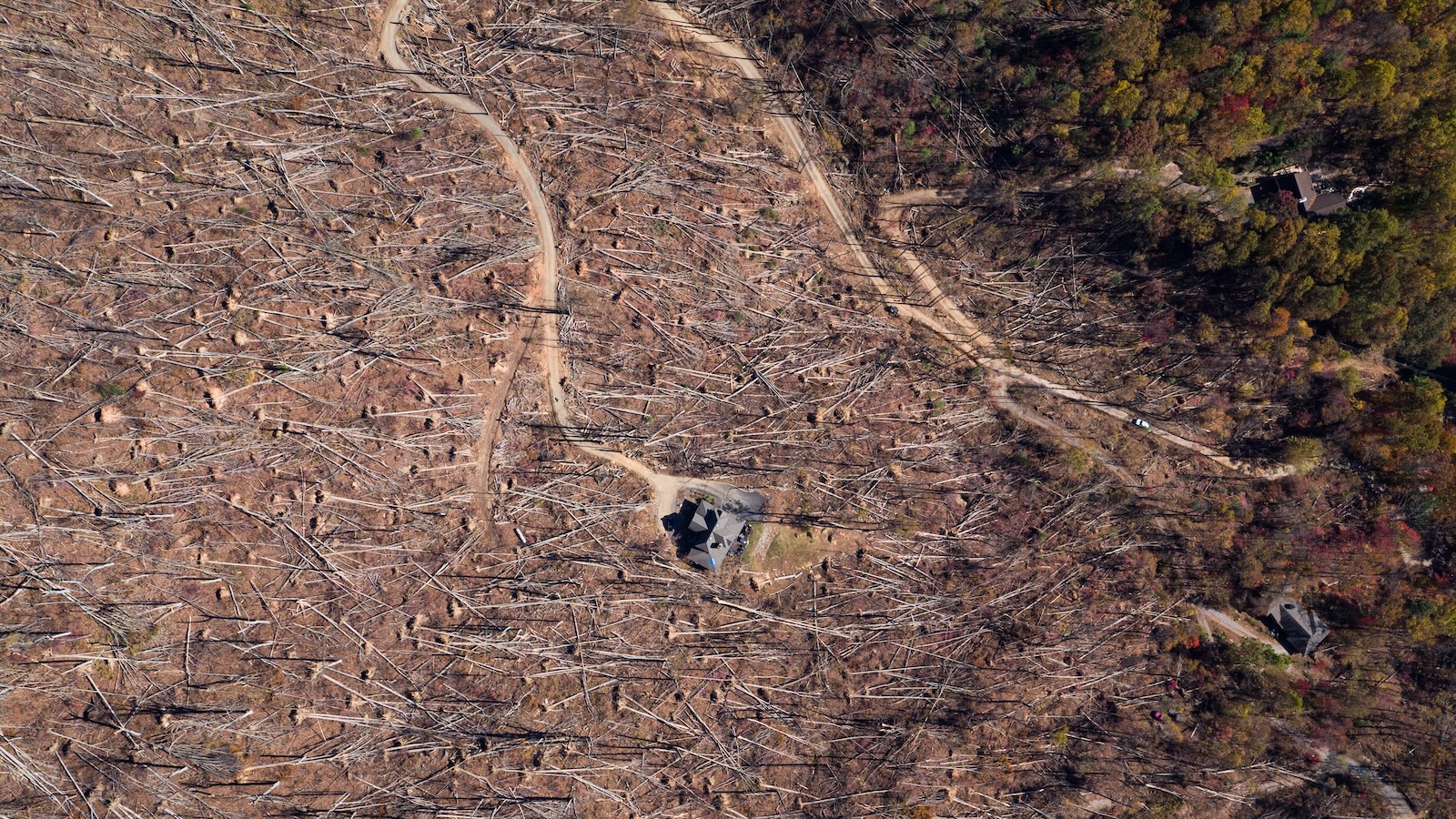In the months after Hurricane Helene leveled thousands of acres in Pisgah National Forest, John Beaudet and other volunteers cleared downed trees from the Appalachian National Scenic Trail. Chopping them up and moving them aside was back-breaking work, but essential to ensuring safe passage for hikers. So he was dismayed to learn that a section of the trail in western North Carolina could remain closed for more than a year because the National Forest Service wants that timber left alone so logging companies can clear it.
“Rather than cut those logs out of the trail and open the trail up, the U.S. Forest Service wanted to salvage those trees as timber,” said Beaudet, an avid hiker who lives near Erwin, Tennessee. Such operations, common after natural disasters like hurricanes and fires, are typically subjected to environmental review, and the government solicits feedback from the public. But when Beaudet tried to comment on the process, he found that was not an option. “For the army of volunteers that work so hard to clear the trail out, it’s kind of a kick in the shins,” he said. The Appalachian Trail Conservancy worked with the Forest Service and local hiking clubs to reroute the trail, but it does not have a timeline for completion for the salvage project, a point of uncertainty for hikers and trail advocates.
Of the nearly 800,000 acres of trees that Helene downed, about 187,000 lie in national forests. Salvage logging is the Forest Service’s primary method of handling such a large disturbance. However, scientists and forest advocates have long questioned whether salvage logging, which brings its own ecological damage, is the best approach and believe it denies nature time to heal. Others argue that such operations are motivated more by profit than safety or environmental concern, and often provide cover for taking healthy trees that still stand.
The fast-track approach to environmental review following Helene has many people concerned that the public isn’t being given any chance to inform the process. According to forest advocates who have been in communication with the Forest Service, the government reportedly plans to announce 15 salvage projects in western North Carolina, including some 2,300 acres in Pisgah alone. The agency did reach out to the state Fish and Wildfire Service and the historic preservation office for consultation, but did not detail what those communications entailed.
Such projects are meant to remove flammable dead trees, create “fuel breaks” where a fire can be halted or slowed, and promote ecosystem regeneration. James Melonas, the supervisor for national forests in North Carolina, said urgency is warranted due to an active and ongoing fire season creating a state of emergency. Beyond providing fuel for conflagrations like those that burned North Carolina last month, felled trees still block many roads.
“Really it’s about reducing that immediate fire risk,” he said. “We’re not really focused at this point on the kind of longer-term forest restoration, which will come.”

Ted Richardson / The Washington Post via Getty Images
Timber salvage is a complex process that requires surveying immense tracts of land, much of it remote and occasionally treacherous, to determine the damage, its impact, and how best to clear it. A scientific assessment, which typically takes about six months, determines the environmental impact of the operation. After that, the environmental impact statement is subject to public comment, after which it is revised into a final version. Once all of that is done, bids are solicited. The cost varies with the scale of the project, any roads that must be built or improved, and other factors, but the baseline is 25 cents per cubic foot of lumber. Then, salvage begins.
Such work is difficult and dangerous. “It’s brutal,” said Bryan Box, a timber cruiser involved in a Helene-related operation in Georgia. His job includes choosing trees for removal and estimating how many trees are hauled off for sale. Clearing them requires working with immense machinery in rugged, often steep, terrain. Accidents can be deadly, and crews toil far from help should anything go wrong.
Salvaging is ecologically disruptive. It can cause erosion, introduce fire-prone invasive plants, alter natural habitat, and impact water quality. That is why it is, like other logging projects, regulated under the National Environmental Policy Act, or NEPA. A forester’s job, Box said, is to use those guidelines to mitigate risks while protecting any endangered species, archaeological sites, or rare habitat. Box has been involved in NEPA reviews around the country, and understands the scientific questions and ecological intricacies involved with salvage.
“The wildlife biologist comes in and says, ‘OK, here’s where our known hawk nests were prior to the storm,” he offered as an example. Or botanists might look for threatened plants like American ginseng. “They have to have language in the environmental impact statement going over that sort of biological analysis.” All of that information is presented in an environmental impact statement and published so the public can review it.
Salvage logging isn’t necessarily profitable, and companies often see it as a chance to squeeze a few dollars out of wood that otherwise might be left to rot. A forest disturbance like a hurricane can devastate local timber markets by making wood suddenly abundant, driving down its value. It doesn’t help that downed trees are less valuable than freshly-cut trees. Box said timber companies sometimes take healthy trees along with the salvage to make more money.
“As long as it’s a targeted salvage project whose aim is simply to remove dead and downed wood, that’s a worthy goal,” said Will Harlan, of the Center for Biological Diversity, who signed a letter asking the Forest Service to allow the public to comment on the projects. “What we get worried about is when the project expands beyond salvage logging to include intact, healthy, mature forests that are nearby, being lumped into the project just to make money.”
The Forest Service does have ways to prevent this. It requires a timber sale administrator to visit logging sites every 14 days to make sure everything is on the up and up. Ideally, these agency employees are “watching like hawks,” Box said. But in reality, there are often so many projects going on at once that an administrator might have over a dozen projects to oversee. And the agency, already stretched thin, may soon see further staffing cuts.
It doesn’t help that there is currently little regulatory pressure from above to enforce the National Environmental Policy Act. Recently released federal directives for the Forest Service invoke the need for logging as a means for preventing fires and promoting biodiversity, and point towards streamlining NEPA and eradicating it where possible.
Some forest ecologists believe salvage is a flawed fire prevention strategy because removing so much timber can actually increase fire risk. Trees, even fallen ones, keep the ground moist and cool; without them, it dries out. “Big logs are creating shade and humidity and don’t dry out that well,” said Josh Kelly, a forest ecologist with conservation nonprofit MountainTrue. “They can actually slow a fire down.” He isn’t opposed to clearing down trees, “so long as salvage really is aimed at reducing wildfire risk and logging debris is dealt with after logging and either chipped or mulched or pulled away from roads. I just really wish there wasn’t this secrecy surrounding it.”
Critics also argue that salvage logging does more harm than good and a damaged forest ought to be left to recover on its own, especially given the trauma it has already endured. “If you look at Webster’s dictionary, salvage is taking something of value from something that’s been destroyed,” said conservation biologist Dominick DelaSalla, an ardent opponent of the practice.
Blowdowns are part of the natural cycles that create the diverse habitats needed to ensure forest health and diversity, he said. Those downed logs have greater value in nurturing life by cycling nutrients and creating habitat, two benefits that outweigh any financial gain gleaned from their harvest. Removing them, he said, can interrupt or alter the process of regrowth, especially when many forest types, like some in Appalachia, are fire-adapted. Rather than clearing downed trees and old growth, DelaSalla said fire mitigation should focus on creating fuel breaks, promoting fire safety education, fireproofing homes, and adopting zoning regulations that minimize further expansion into the wildland-urban interface.
Kelly said while smaller twigs downed by Helene may be linked to the fires that burned last month, and the downed trees littering Pisgah and other forests may not pose a threat until they’ve had a few years to dry out. Other factors post a far greater threat, he said. “The Southeast in general has been having a very active fire season due to global warming and weather,” he said. Last month was the lowest-humidity March on record for much of the region.
Ultimately, conservationists would prefer a stewardship-based approach to letting damaged forests regenerate at their own pace. That approach can conflict with the pressure to maintain public safety, the federal government’s interest in increasing logging, and the economic benefits recreation and tourism bring to communities. Such tensions will only increase as climate change brings more frequent, and more intense storms like Helene and the nation’s forests grow increasingly vulnerable.
“What we’re going to continue to see is probably increased rates of canopy turnover, increased mortality rates of the older trees, and a changing species composition and conditions,” said Kelly. “There won’t be an equilibrium until the climate and weather reach an equilibrium.”
Lilly Knoepp contributed reporting to this story.


